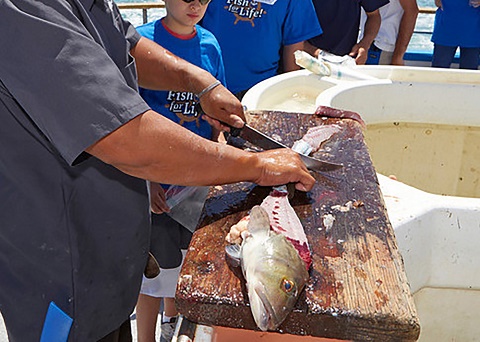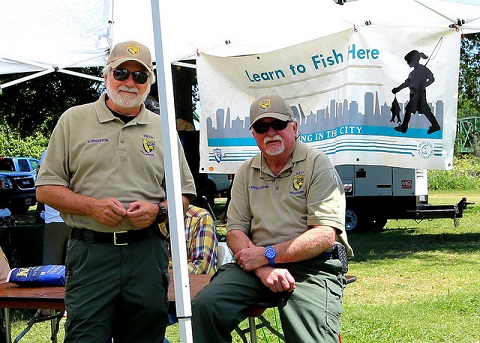From Sportfishing
Fish Report for 1-20-2017

“Butterflying” a Legal Alternative to Traditional Filleting?
1-20-2017
Carrie Wilson
Question: As an alternative to traditional filleting, some people will do what they call “butterflying.” This is where fish are filleted but the cut is not completed leaving the fillet connected to the skin and the skin attached to the carcass. Is that technique legal for striped bass and sharks? I believe it’s not permissible to fillet greenlings and cabezon at sea. That is where I have seen this done in the past by deckhands that want to be able to make a buck filleting onboard without violating the regs. The patron just pulls the pieces apart when dockside to separate the fillet from the remainder. I just want to see if perhaps further clarification directly to the individual might help them, should they be a deckhand checking to see if there is some means of cutting fish at sea. This might be worth running by a warden to be sure that the butterfly trick is legit. (John B.)
Answer: It is illegal to possess fish on a boat in such condition that the size and species cannot be determined (Fish and Game Code, sections 5508 and 5509). Fillet laws allow for the fillet of certain species as sea (under California Code of Regulations Title 14, section 27.65) consistent with identification requirements specified in the rule (such as retention of attached skin patches or the entire skin of a rockfish). Other than the provisions allowing for the fillet of certain species, no one should jeopardize the ability to identify the species and size of ocean fish. Striped bass, sharks, greenlings and cabezon may not be filleted at sea. So, if the person filleting your fish at sea, while rolling back and forth, makes a mistake and removes the whole piece of skin, you would be in violation. To be safe, the butterflying can occur once the fish are landed.
Determining when and where a gun is considered “loaded”?
Question: Please clarify the definition of “loaded” that you gave in your column: “Live round in the chamber.” Is it okay to have the clip or magazine loaded if there’s no round in the chamber? (Will B., Palmdale)
Answer: This is a classic example of the answer depending on where you are and what activity you are engaged in. Loaded gun laws applying to vehicles on roads open to the public have changed over the years, and there are differences in the definitions of loaded between the Fish and Game Code and the Penal Code. Long guns are considered to be loaded “when there is an unexpended cartridge or shell in the firing chamber but not when the only cartridges or shells are in the magazine” (FGC, section 2006). Under the Penal Code, a firearm is also considered to be loaded if there is a round in the magazine that can be loaded into the firing chamber with the firearm’s action.
So if you are in a vehicle along a public roadway while hunting, the Fish and Game Code does not prohibit rounds in the magazine of the rifle or shotgun, but rounds in the firing chamber would violate Fish and Game Code section 2006. The situation is different when you’re not hunting though. The Penal Code treats a firearm as loaded when a round is in the magazine, and Penal Code section 25850 provides that “a person is guilty of carrying a loaded firearm when the person carries a loaded firearm on the person or in a vehicle while in any public place or on any public street in an incorporated city or in any public place or on any public street in a prohibited area of unincorporated territory.”
Fishing with live minnows purchased at a bait shop?
Question: I know it’s illegal to move live finfish, so how can it be legal to use live minnows purchased from a bait shop for sport fishing in inland waters? (Mike R.)
Answer: It depends upon what area of the state the minnows are purchased in and where they are used. The term “minnow” often refers to many different species of small baitfish, some of which belong to the minnow family. Some lakes no longer allow the use of live bait due to possible water contamination (quagga or zebra mussels) in the water containing the bait fish. Depending upon where in the state you plan to use the minnows and, more specifically, which species of minnow (e.g. longjaw mudsucker, fathead minnow, Mississippi silverside, etc.), you will need to check the appropriate baitfish regulations that apply to the specific waters where you intend to fish. Please check sections 4.00 – 4.30 on pages 16-18 in the 2016-2017 Freshwater Sport Fishing Regulations handbook for these regulations.
Carrie Wilson is a marine environmental scientist with the California Department of Fish and Wildlife. While she cannot personally answer everyone’s questions, she will select a few to answer each week in this column. Please contact her at CalOutdoors@wildlife.ca.gov.
< Previous Report Next Report >
More Reports
California Department of Fish & Wildlife Reports
for Friday, January 20th, 2017
• CDFW expands presence at ISE in Sacramento
• CDFW Releases New Guide to Heritage Trout Challenge

1-18-2017
The California Department of Fish and Wildlife (CDFW) is currently seeking applicants for its Natural Resource Volunteer Program (NRVP) in...... Read More

Website Hosting and Design provided by TECK.net